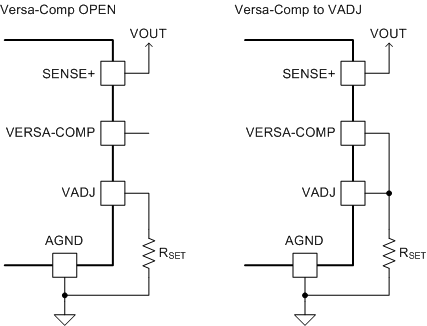SNVSAJ2C March 2016 – June 2018 LMZ34202
PRODUCTION DATA.
- 1 Features
- 2 Applications
- 3 Description
- 4 Revision History
- 5 Pin Configuration and Functions
- 6 Specifications
-
7 Detailed Description
- 7.1 Overview
- 7.2 Functional Block Diagram
- 7.3
Feature Description
- 7.3.1 Adjusting the Output Voltage
- 7.3.2 Switching Frequency (RT)
- 7.3.3 Recommended Operating Range
- 7.3.4 Synchronization (CLK)
- 7.3.5 Output Capacitor Selection
- 7.3.6 VERSA-COMP Pin Configurations
- 7.3.7 Input Capacitor Selection
- 7.3.8 Output On/Off Inhibit (INH/UVLO)
- 7.3.9 Under Voltage Lockout (UVLO)
- 7.3.10 Remote Sense
- 7.3.11 VBSEL
- 7.3.12 Soft-Start (SS/TR)
- 7.3.13 Power Good (PWRGD) and Pull-up (PWRGD_PU)
- 7.3.14 Overcurrent Protection
- 7.3.15 Thermal Shutdown
- 7.4 Device Functional Modes
- 8 Application and Implementation
- 9 Power Supply Recommendations
- 10Layout
- 11Device and Documentation Support
- 12Mechanical, Packaging, and Orderable Information
Package Options
Mechanical Data (Package|Pins)
- RVQ|43
Thermal pad, mechanical data (Package|Pins)
Orderable Information
7.3.6 VERSA-COMP Pin Configurations
The versa-comp feature of the LMZ34202 allows a simple method to adjust the internal compensation network to provide the optimized phase and gain margin based on the output voltage. This easy-to-use feature requires no external components and is implemented by the simple configuration of two adjacent pins on the module.
The versa-comp feature must be configured in one of two ways; VERSA-COMP pin left OPEN or VERSA-COMP pin tied to VADJ. The output voltage determines the appropriate Versa-Comp pin configuration. Table 8 lists the Versa-Comp configuration. Figure 19 shows the two possible Versa-Comp pin configurations.
 Figure 19. Versa-Comp Configurations
Figure 19. Versa-Comp Configurations Table 8. VERSA-COMP Pin Configurations
| VOUT RANGE (V) | VERSA-COMP PIN CONFIGURATION | |
|---|---|---|
| MIN | MAX | |
| 2.5 | < 3.0 | OPEN |
| 3.0 | 7.5 | Connect to VADJ |